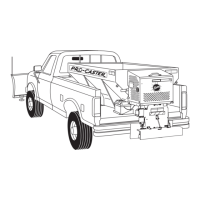Lit. No. 95902/95903, Rev. 01 3 June 15, 2008
SAFETY INFORMATION
BATTERY SAFETY
NOISE
Airborne noise emission during use is below 70 dB(A)
for the spreader operator.
TORQUE CHART
Recommended Fastener Torque
Chart (ft-lb)
Size
SAE
Grade 2
SAE
Grade 5
SAE
Grade 8
1/4-20
5/16-18
3/8-16
3/8-24
7/16-14
1/2-13
9/16-12
5/8-11
3/4-10
7/8-9
1-8
6
11
19
24
30
45
66
93
150
150
220
9
18
31
46
50
75
110
150
250
378
583
13
28
46
68
75
115
165
225
370
591
893
Metric Grade 8.8 (ft-lb)
Size TorqueSize
Torque
M 6
M 8
M 10
M 12
M 14
M 16
7
17
35
60
95
155
These torque values apply to fasteners
except those noted in the instruction.
CAUTION
Read instructions before assembling.
Fasteners should be fi nger tight until
instructed to tighten according to torque
chart. Use standard methods and practices
when attaching spreader including proper
personal protective safety equipment.
CAUTION
Batteries normally produce explosive gases
that can cause personal injury. Therefore,
do not allow fl ames, sparks, or lit tobacco
to come near battery. When charging or
working near a battery, always cover your
face and protect your eyes, and also provide
ventilation.
• Batteries contain sulfuric acid that burns
skin, eyes and clothing.
• Disconnect the battery before removing or
replacing any electrical components.
FUSES
The electrical system contains automotive blade-style
fuses. If a problem should occur and fuse replacement
is necessary, the replacement fuse must be of the
same type and amperage rating as the original.
Installing a fuse with a higher rating can damage the
system and could start a fi re. Fuse Replacement,
including fuse ratings and locations, is located in the
Maintenance Section of this Owner's Manual.
PERSONAL SAFETY
• Remove ignition key and put the vehicle in park or
in gear to prevent others from starting the vehicle
during installation or service.
• Wear only snug-fi tting clothing while working on
your vehicle or spreader.
• Do not wear jewelry or a necktie, and secure long
hair.
• Wear safety goggles to protect your eyes from
battery acid, gasoline, dirt and dust.
• Avoid touching hot surfaces such as the engine,
radiator, hoses and exhaust pipes.
• Always have a fi re extinguisher rated BC handy,
for fl ammable liquids and electrical fi res.
FIRE AND EXPLOSION
Be careful when using gasoline. Do not use gasoline
to clean parts. Store only in approved containers away
from sources of heat or fl ame.
CELL PHONES
A driver's fi rst responsibility is the safe operation of
the vehicle. The most important thing you can do
to prevent a crash is to avoid distractions and pay
attention to the road. Wait until it is safe to operate
Mobile Communication Equipment such as cell
phones or two-way radios.
VENTILATION
WARNING
Vehicle exhaust contains lethal fumes.
Breathing these fumes, even in low
concentrations, can cause death. Never
operate a vehicle in an enclosed area without
venting exhaust to the outside.

